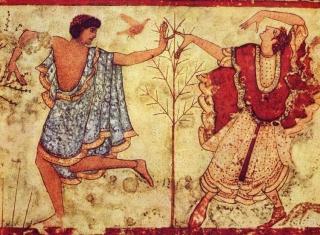
Humanities West brings together a panel of noted scholars and performers to present a unique lecture-performance event that takes its audience on a journey to Italy, between the 8th and 2nd century BCE. Etruscan Italy: Life and Afterlife celebrates a sophisticated and wealthy people, whose vibrant past has been revealed through their material culture, as discovered in tombs, temples, habitation sites, and more. This program examines the Etruscans as major contributors to some of Western civilization’s greatest achievements in architecture, engineering, politics and art, offering new perspectives and insights to broaden our understanding and demystify Etruscan life and afterlife.
The program opens Friday evening with a presentation by Lisa C. Pieraccini (UC Berkeley) titled Etruscan Life and Afterlife Revisited. Pieraccini provides an introduction and overview of the rich and complex Etruscan society and culture as uncovered through archaeological remains of buildings and towns, as well as vase paintings, sculpture and jewelry.
A special musical performance, Etruscans at the Opera: Highlights from Benjamin Britten’s The Rape of Lucretia, introduced by Clifford ‘Kip’ Cranna (Dramaturg Emeritus, SF Opera) follows. The performance features Hope Briggs (soprano), Eugene Brancoveanu (baritone), and Christopher Colmenero (tenor), with Chantal Grybas (mezzo-soprano) singing the title role, accompanied by Kevin Korth (piano).
On Saturday, Ingrid Edlund-Berry (University of Texas) presents Etruscan Development of Organized Government and City-States, exploring Etruscan political power as manifested through an intricate pattern of local government in which each city-state prospered on its own terms, and where individuality was used as a tool to create unity and strength.
Christopher Hallett (UC Berkeley) follows with a presentation on The Etruscans in the Roman Imagination. This presentation will discuss Rome’s interest in the Etruscans during the reign of Augustus (ca. 30 BCE). Hallett uncovers what this Roman generation chose to remember about their great predecessors and what they made of the legends, art, and structures that survived.
The program continues with Quintessentially Etruscan: Art and Architecture: Villanovan to Etrusco-Roman, a lecture by Alexandra Carpino (Northern Arizona University). Carpino’s talk delves into temples, tombs, vases, and jewelry created by Etruscan artists and craftsmen, to look for statements about Etruscan society, its wealth, beliefs, and traditions.
Lisa C. Pieraccini returns to give the final lecture on The Rediscovery of the Etruscans: A Retrospective. This presentation traces the reception of certain aspects of Etruscan culture over several centuries to the present. Examples of Etruscan reception, including monuments, forgeries, the borrowing of imagery, and subjects of literary works, illustrate the varying motivations through the ages for appropriating the Etruscans. Dr. Pieraccini seeks to illuminate where the Etruscans have gone and suggest where they still might be going.
